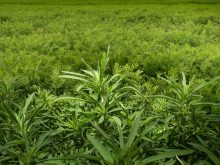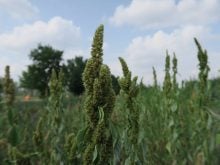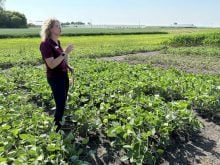Scientists at the University of Adelaide in Australia have discovered a technique to use antibiotics previously used in laboratory experiments and discarded to create herbicides with new modes of action that can better fight herbicide-resistant weeds.
With modifications, a molecule initially developed to treat tuberculosis but failed to get beyond the research lab showed an ability to kill two of the most problematic weeds in Australia, annual ryegrass and wild radish, without harming bacterial and human cells.
“This discovery is a potential game changer for the agricultural industry,” said Tatiana Soares da Costa with the University’s Waite Research Institute. “Many weeds are now resistant to the existing herbicides on the market, costing farmers billions of dollars each year.”
Read Also

Huge Black Sea flax crop to provide stiff competition
Russia and Kazakhstan harvested huge flax crops and will be providing stiff competition in China and the EU.
She said that using failed antibiotics as herbicides could provide a short-cut for faster development of new, more effective weed killers.
“My lab made the discovery that essential processes found in bacteria were also found in weeds,” said Soares da Costa. “This includes processes used to make nutrients like amino acids. The idea developed to leverage research already done to tackle antibiotic resistance and apply it to herbicide resistance in weeds.”
At the university’s Herbicide and Antibiotic Innovation Lab, researchers found that there were similarities between bacterial superbugs and weeds at a molecular level. By exploiting those similarities and chemically modifying the structure of the failed antibiotic, they could block the production of amino acid lysine, which is essential for weed growth.
Experiments showed that, by inhibiting lysine biosynthesis in plants, it severely reduced the germination of the model plant Arabidopsis thaliana.
The research also showed that the lead compound is the first lysine biosynthesis inhibitor with activity against both monocot and dicot weed species, showing clear ability to reduce the germination and growth of rigid ryegrass and wild radish.
The report stated the results provide proof that the new inhibition process may not only represent a much-needed new generation of herbicide, but illustrate an untapped potential to re-purpose failed antibiotics shelved in the lab and put them to valuable use as herbicides in farm fields.
“The original failed antibiotic did not kill bacteria but could kill weeds at very high dosages,” said Soares da Costa. “We strategically changed some structural components of the failed antibiotic to make molecules that were more potent against weeds but still had no effect on bacteria.”
She said that more studies need to be done to look further at their potential as herbicides, including testing their efficacy against various weeds, selectivity for crops, toxicity and large-scale production.
The development of the antibiotic as a successful herbicide comes when there are no commercially available herbicides on the market that work in the way the antibiotic molecule functions.
“In the past 40 years, there have been hardly any new herbicides with new mechanisms of action that have entered the market,” said Andrew Barrow, a postdoctoral researcher on Soares da Costa’s team.
“Our re-purposing approach has the potential to discover (more) herbicides with broad activity, which kill a wide variety of weeds,” said Soares da Costa. “Given the lack of new herbicides that have entered the market in the past 40 years, our compounds and overarching strategy have the potential to be applied at various levels.”
The re-purposing approach has the potential to develop herbicides with new modes of action that allow them to work differently to products already on the market and work effectively against weeds that are resistant to current herbicides.
Soares da Costa emphasized that the study was focused on failed antibiotics only, ones that have never left the test laboratory as they failed to kill bacteria. In the re-purposed antibiotic study, the molecule processes are not found in animals or humans and do not kill bacteria. They specifically target weeds with no effects on human cells.
The research was published in the journal Communications Biology.

















